本文转自《零基础入门深度学习》系列文章,阅读原文请移步这里
之前我们介绍了循环神经网络以及它的训练算法。我们也介绍了循环神经网络很难训练的原因,这导致了它在实际应用中,很难处理长距离的依赖。在本文中,我们将介绍一种改进之后的循环神经网络:长短时记忆网络(Long Short Term Memory Network, LSTM),它成功的解决了原始循环神经网络的缺陷,成为当前最流行的RNN,在语音识别、图片描述、自然语言处理等许多领域中成功应用。但不幸的一面是,LSTM的结构很复杂,因此,我们需要花上一些力气,才能把LSTM以及它的训练算法弄明白。在搞清楚LSTM之后,我们再介绍一种LSTM的变体:GRU (Gated Recurrent Unit)。 它的结构比LSTM简单,而效果却和LSTM一样好,因此,它正在逐渐流行起来。最后,我们仍然会动手实现一个LSTM。
一、长短时记忆网络是啥
我们首先了解一下长短时记忆网络产生的背景。回顾一下《深度学习之循环神经网络(RNN)》中推导的,误差项沿时间反向传播的公式: δ k T = δ t T ∏ i = k t − 1 d i a g [ f ′ ( n e t i ) ] W \delta_k^T= \delta_t^T\prod_{i=k}^{t-1}diag[f'(net_i)]W δkT=δtTi=k∏t−1diag[f′(neti)]W我们可以根据下面的不等式,来获取 δ k T \delta_k^T δkT的模的上界(模可以看做对 δ k T \delta_k^T δkT中每一项值的大小的度量): ∥ δ k T ∥ ⩽ ∥ δ t T ∥ ∏ i = k t − 1 ∥ W ∥ ∥ d i a g [ f ′ ( n e t i ) ] ∥ \lVert\delta_k^T\rVert\leqslant\lVert\delta_t^T\rVert\prod_{i=k}^{t-1}\lVert W \rVert\lVert diag[f'(net_i)]\rVert ∥δkT∥⩽∥δtT∥i=k∏t−1∥W∥∥diag[f′(neti)]∥ ⩽ ∥ δ t T ∥ ( β W β f ) t − k \leqslant\lVert\delta_t^T\rVert(\beta_W\beta_f)^{t-k}\space\space\space\space\space\space\space\space\space\space\space\space\space ⩽∥δtT∥(βWβf)t−k 我们可以看到,误差项 δ \delta δ从t时刻传递到k时刻,其值的上界是 β f β w \beta_f\beta_w βfβw的指数函数。 β f β w \beta_f\beta_w βfβw分别是对角矩阵 d i a g [ f ′ ( n e t i ) ] diag[f'(net_i)] diag[f′(neti)]和矩阵 W W W模的上界。显然,除非 β f β w \beta_f\beta_w βfβw乘积的值位于1附近,否则,当t-k很大时(也就是误差传递很多个时刻时),整个式子的值就会变得极小(当 β f β w \beta_f\beta_w βfβw乘积小于1)或者极大(当 β f β w \beta_f\beta_w βfβw乘积大于1),前者就是梯度消失,后者就是梯度爆炸。虽然科学家们搞出了很多技巧(比如怎样初始化权重),让的值尽可能贴近于1,终究还是难以抵挡指数函数的威力。
梯度消失到底意味着什么?在《深度学习之循环神经网络(RNN)》中我们已证明,权重数组W最终的梯度是各个时刻的梯度之和,即:
∇
W
E
=
∑
i
=
1
t
∇
W
t
E
\nabla_{W}E=\sum_{i=1}^t\nabla_{W_t}E\space\space\space\space\space\space\space\space\space\space\space\space\space\space\space\space\space\space\space\space\space\space\space\space\space
∇WE=i=1∑t∇WtE
=
∇
W
t
E
+
∇
W
t
−
1
E
+
.
.
.
+
∇
W
1
E
\space\space\space\space\space\space\space\space\space\space\space\space\space\space\space\space\space\space\space\space\space\space=\nabla_{W_t}E+\nabla_{W_{t-1}}E+...+\nabla_{W_1}E
=∇WtE+∇Wt−1E+...+∇W1E假设某轮训练中,各时刻的梯度以及最终的梯度之和如下图: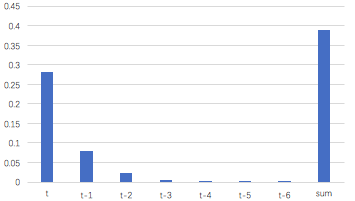
我们就可以看到,从上图的t-3时刻开始,梯度已经几乎减少到0了。那么,从这个时刻开始再往之前走,得到的梯度(几乎为零)就不会对最终的梯度值有任何贡献,这就相当于无论t-3时刻之前的网络状态h是什么,在训练中都不会对权重数组W的更新产生影响,也就是网络事实上已经忽略了t-3时刻之前的状态。这就是原始RNN无法处理长距离依赖的原因。
既然找到了问题的原因,那么我们就能解决它。从问题的定位到解决,科学家们大概花了7、8年时间。终于有一天,Hochreiter和Schmidhuber两位科学家发明出长短时记忆网络,一举解决这个问题。
其实,长短时记忆网络的思路比较简单。原始RNN的隐藏层只有一个状态,即h,它对于短期的输入非常敏感。那么,假如我们再增加一个状态,即c,让它来保存长期的状态,那么问题不就解决了么?如下图所示:
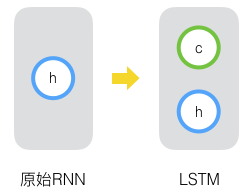
新增加的状态c,称为单元状态(cell state)。我们把上图按照时间维度展开:
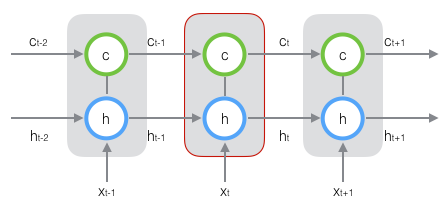
上图仅仅是一个示意图,我们可以看出,在t时刻,LSTM的输入有三个:当前时刻网络的输入值
x
t
\mathbf{x}_t
xt、上一时刻LSTM的输出值
h
t
−
1
\mathbf{h}_{t-1}
ht−1、以及上一时刻的单元状态
c
t
−
1
\mathbf{c}_{t-1}
ct−1;LSTM的输出有两个:当前时刻LSTM输出值
h
t
\mathbf{h}_{t}
ht、和当前时刻的单元状态
c
t
\mathbf{c}_{t}
ct。注意
x
、
h
、
c
\mathbf{x}、\mathbf{h}、\mathbf{c}
x、h、c都是向量。
LSTM的关键,就是怎样控制长期状态
c
c
c。在这里,LSTM的思路是使用三个控制开关。第一个开关,负责控制继续保存长期状态
c
c
c;第二个开关,负责控制把即时状态输入到长期状态
c
c
c;第三个开关,负责控制是否把长期状态
c
c
c作为当前的LSTM的输出。三个开关的作用如下图所示:
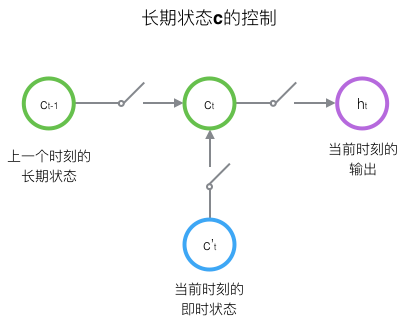
接下来,我们要描述一下,输出h和单元状态c的具体计算方法。
二、长短时记忆网络的前向计算
前面描述的开关是怎样在算法中实现的呢?这就用到了门(gate)的概念。门实际上就是一层全连接层,它的输入是一个向量,输出是一个0到1之间的实数向量。假设 W W W是门的权重向量, b \mathbf{b} b是偏置项,那么门可以表示为: g ( x ) = σ ( W x + b ) g(x)=\sigma(W\mathbf{x}+\mathbf{b}) g(x)=σ(Wx+b)门的使用,就是用门的输出向量按元素乘以我们需要控制的那个向量。因为门的输出是0到1之间的实数向量,那么,当门输出为0时,任何向量与之相乘都会得到0向量,这就相当于啥都不能通过;输出为1时,任何向量与之相乘都不会有任何改变,这就相当于啥都可以通过。因为 σ \sigma σ(也就是sigmoid函数)的值域是(0,1),所以门的状态都是半开半闭的。
LSTM用两个门来控制单元状态 c c c的内容,一个是遗忘门(forget gate),它决定了上一时刻的单元状态 c t − 1 \mathbf{c}_{t-1} ct−1有多少保留到当前时刻 c t \mathbf{c}_{t} ct;另一个是输入门(input gate),它决定了当前时刻网络的输入 x t \mathbf{x}_t xt有多少保存到单元状态 c t \mathbf{c}_t ct。LSTM用输出门(output gate)来控制单元状态 c t \mathbf{c}_t ct有多少输出到LSTM的当前输出值 h t \mathbf{h}_t ht。
我们先来看一下遗忘门:
f
t
=
σ
(
W
f
⋅
[
h
t
−
1
,
x
t
]
+
b
f
)
(
式
1
)
\mathbf{f}_t=\sigma(W_f·[\mathbf{h}_{t-1},\mathbf{x}_t]+\mathbf{b}_f)\space\space\space\space\space\space(式1)
ft=σ(Wf⋅[ht−1,xt]+bf) (式1)上式中,
W
f
W_f
Wf是遗忘门的权重矩阵,
[
h
t
−
1
,
x
t
]
[\mathbf{h}_{t-1},\mathbf{x}_t]
[ht−1,xt]表示把两个向量连接成一个更长的向量,
b
f
\mathbf{b}_f
bf是遗忘门的偏置项,
σ
\sigma
σ是sigmoid函数。如果输入的维度是
d
x
d_x
dx,隐藏层的维度是
d
h
d_h
dh,单元状态的维度是
d
c
d_c
dc(通常
d
c
=
d
h
d_c=d_h
dc=dh),则遗忘门的权重矩阵
W
f
W_f
Wf维度是
d
c
×
(
d
h
+
d
x
)
d_c\times (d_h+d_x)
dc×(dh+dx)。事实上,权重矩阵
W
f
W_f
Wf都是两个矩阵拼接而成的:一个是
W
f
h
W_{fh}
Wfh,它对应着输入项
h
t
−
1
\mathbf{h}_{t-1}
ht−1,其维度为
d
c
×
d
h
d_c\times d_h
dc×dh;一个是
W
f
x
W_{fx}
Wfx,它对应着输入项
x
t
\mathbf{x}_t
xt,其维度为
d
c
×
d
x
d_c \times d_x
dc×dx。
W
f
W_f
Wf可以写为:
[
W
f
]
[
h
t
−
1
x
t
]
=
[
W
f
h
W
f
x
]
[
h
t
−
1
x
t
]
[W_f]\begin{bmatrix} \mathbf{h}_{t-1} \\ \mathbf{x}_t \end{bmatrix}=\begin{bmatrix} W_{fh}\space\space W_{fx}\end{bmatrix}\begin{bmatrix} \mathbf{h}_{t-1} \\ \mathbf{x}_t\end{bmatrix}\space\space\space\space\space\space\space\space\space\space\space\space
[Wf][ht−1xt]=[Wfh Wfx][ht−1xt]
=
W
f
h
h
t
−
1
+
W
f
x
x
t
\space\space\space\space\space\space\space=W_{fh}\mathbf{h}_{t-1}+W_{fx}\mathbf{x}_t
=Wfhht−1+Wfxxt下图显示了遗忘门的计算:

接下来看看输入门:
i
t
=
σ
(
W
i
⋅
[
h
t
−
1
,
x
t
]
+
b
i
)
(
式
2
)
\mathbf{i}_t=\sigma(W_i·[\mathbf{h}_{t-1},\mathbf{x}_t]+\mathbf{b}_i)\space\space\space\space\space\space(式2)
it=σ(Wi⋅[ht−1,xt]+bi) (式2)上式中,
W
i
W_i
Wi是输入门的权重矩阵,
b
i
\mathbf{b}_i
bi是输入门的偏置项。下图表示了输入门的计算:
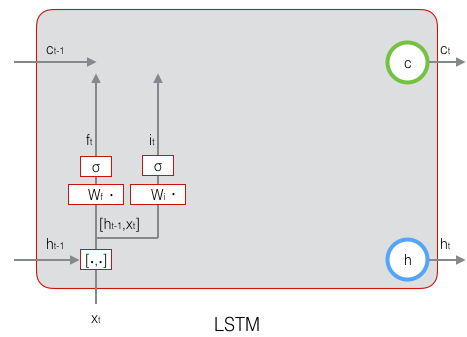
接下来,我们计算用于描述当前输入的单元状态
c
~
t
\tilde \mathbf{c}_t
c~t,它是根据上一次的输出和本次输入来计算的:
c
~
t
=
t
a
n
h
(
W
c
⋅
[
h
t
−
1
,
x
t
]
+
b
c
)
(
式
3
)
\tilde \mathbf{c}_t=tanh(W_c·[\mathbf{h}_{t-1},\mathbf{x}_t] + \mathbf{b}_c)\space\space\space\space\space\space(式3)
c~t=tanh(Wc⋅[ht−1,xt]+bc) (式3)下图是
c
~
t
\tilde \mathbf{c}_t
c~t的计算:
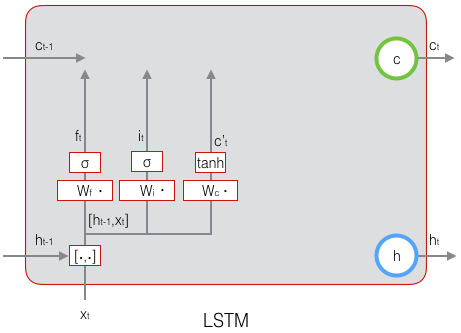
现在,我们计算当前时刻的单元状态
c
t
\mathbf{c}_t
ct。它是由上一次的单元状态
c
t
−
1
\mathbf{c}_{t-1}
ct−1按元素乘以遗忘门
f
t
f_t
ft,再用当前输入的单元状态
c
~
t
\tilde \mathbf{c}_t
c~t按元素乘以输入门
i
t
i_t
it,再将两个积加和产生的:
c
t
=
f
t
∘
c
−
1
+
i
t
∘
c
~
t
(
式
4
)
\mathbf{c}_t=f_t\circ \mathbf{c}_{-1}+i_t \circ \tilde \mathbf{c}_t\space\space\space\space\space\space(式4)
ct=ft∘c−1+it∘c~t (式4)符号
∘
\circ
∘表示按元素乘。下图是
c
t
\mathbf{c}_t
ct的计算: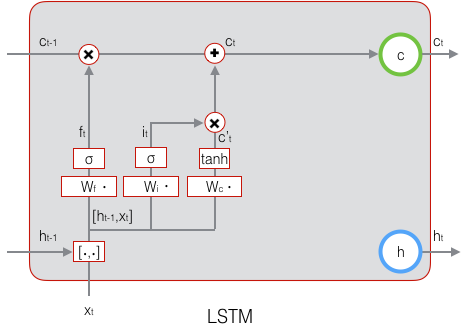
这样,我们就把LSTM关于当前的记忆
c
~
t
\tilde \mathbf{c}_t
c~t和长期的记忆
c
t
−
1
\mathbf{c}_{t-1}
ct−1组合在一起,形成了新的单元状态
c
t
\mathbf{c}_t
ct。由于遗忘门的控制,它可以保存很久很久之前的信息,由于输入门的控制,它又可以避免当前无关紧要的内容进入记忆。下面,我们要看看输出门,它控制了长期记忆对当前输出的影响:
o
t
=
σ
(
W
o
⋅
[
h
t
−
1
,
x
t
]
+
b
o
)
(
式
5
)
\mathbf{o}_t=\sigma(W_o·[\mathbf{h}_{t-1}, \mathbf{x}_t]+\mathbf{b}_o)\space\space\space\space\space\space(式5)
ot=σ(Wo⋅[ht−1,xt]+bo) (式5)下图表示输出门的计算: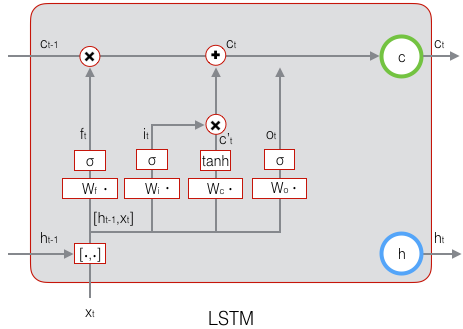
LSTM最终的输出,是由输出门和单元状态共同确定的:
h
t
=
o
t
∘
t
a
n
h
(
c
t
)
(
式
6
)
\mathbf{h}_t=\mathbf{o}_t \circ tanh(\mathbf{c}_t)\space\space\space\space\space\space(式6)
ht=ot∘tanh(ct) (式6)下图表示LSTM最终输出的计算: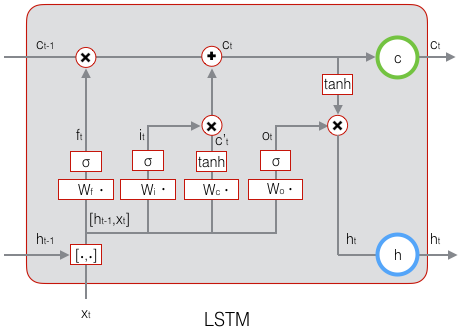
(式1)到(式6)就是LSTM前向计算的全部公式。至此,我们就把LSTM前向计算讲完了。
三、长短时记忆网络的训练
熟悉我们这个系列文章的同学都清楚,训练部分往往比前向计算部分复杂多了。LSTM的前向计算都这么复杂,那么,可想而知,它的训练算法一定是非常非常复杂的。现在只有做几次深呼吸,再一头扎进公式海洋吧。
LSTM训练算法框架
LSTM的训练算法仍然是反向传播算法,对于这个算法,我们已经非常熟悉了。主要有下面三个步骤:
- 前向计算每个神经元的输出值,对于LSTM来说,即 f t 、 i t 、 c t 、 o t 、 h t \mathbf{f}_t、\mathbf{i}_t、\mathbf{c}_t、\mathbf{o}_t、\mathbf{h}_t ft、it、ct、ot、ht五个向量的值。计算方法已经在上一节中描述过了。
- 反向计算每个神经元的误差项 δ \delta δ值。与循环神经网络一样,LSTM误差项的反向传播也是包括两个方向:一个是沿时间的反向传播,即从当前t时刻开始,计算每个时刻的误差项;一个是将误差项向上一层传播。
- 根据相应的误差项,计算每个权重的梯度。
关于公式和符号的说明
首先,我们对推导中用到的一些公式、符号做一下必要的说明。
接下来的推导中,我们设定gate的激活函数为sigmoid函数,输出的激活函数为tanh函数。他们的导数分别为:
σ
(
z
)
=
y
=
1
1
+
e
−
z
\sigma(z)=y=\frac{1}{1+e^{-z}}
σ(z)=y=1+e−z1
σ
′
(
z
)
=
y
(
1
−
y
)
\sigma'(z)=y(1-y)\space\space\space\space\space\space\space\space
σ′(z)=y(1−y)
t
a
n
h
(
z
)
=
y
=
e
z
−
e
−
z
e
z
+
e
−
z
tanh(z)=y=\frac{e^z-e^{-z}}{e^z+e^{-z}}\space\space\space\space
tanh(z)=y=ez+e−zez−e−z
t
a
n
h
′
(
z
)
=
1
−
y
2
tanh'(z)=1-y^2\space\space\space\space\space\space\space\space\space\space\space\space\space\space\space\space\space
tanh′(z)=1−y2 从上面可以看出,sigmoid和tanh函数的导数都是原函数的函数。这样,我们一旦计算原函数的值,就可以用它来计算出导数的值。
LSTM需要学习的参数共有8组,分别是:遗忘门的权重矩阵 W f W_f Wf和偏置项 b f \mathbf{b}_f bf、输入门的权重矩阵 W i W_i Wi和偏置项 b i \mathbf{b}_i bi、输出门的权重矩阵 W o W_o Wo和偏置项 b o \mathbf{b}_o bo,以及计算单元状态的权重矩阵 W c W_c Wc和偏置项 b c \mathbf{b}_c bc。因为权重矩阵的两部分在反向传播中使用不同的公式,因此在后续的推导中,权重矩阵 W f 、 W i 、 W o 、 W c W_f、W_i、W_o、W_c Wf、Wi、Wo、Wc都将被写为分开的两个矩阵: W f h 、 W f x 、 W i h 、 W i x 、 W o h 、 W o x 、 W c h 、 W c x W_{fh}、W_{fx}、W_{ih}、W_{ix}、W_{oh}、W_{ox}、W_{ch}、W_{cx} Wfh、Wfx、Wih、Wix、Woh、Wox、Wch、Wcx。
我们解释一下按元素乘 ∘ \circ ∘符号。当 ∘ \circ ∘作用于两个向量时,运算如下: a ∘ b = [ a 1 a 2 a 3 . . . a n ] ∘ [ b 1 b 2 b 3 . . . b n ] = [ a 1 b 1 a 2 b 2 a 3 b 3 . . . a n b n ] a \circ b=\begin{bmatrix} a_1 \\ a_2\\ a_3\\...\\a_n \end{bmatrix} \circ \begin{bmatrix} b_1 \\ b_2\\ b_3\\...\\b_n \end{bmatrix} = \begin{bmatrix} a_1b_1 \\ a_2b_2\\ a_3b_3\\...\\a_nb_n \end{bmatrix} a∘b=⎣⎢⎢⎢⎢⎡a1a2a3...an⎦⎥⎥⎥⎥⎤∘⎣⎢⎢⎢⎢⎡b1b2b3...bn⎦⎥⎥⎥⎥⎤=⎣⎢⎢⎢⎢⎡a1b1a2b2a3b3...anbn⎦⎥⎥⎥⎥⎤当 ∘ \circ ∘作用于一个向量和一个矩阵时,运算如下: a ∘ X = [ a 1 a 2 a 3 . . . a n ] ∘ [ x 11 x 12 . . . x 1 n x 21 x 22 . . . x 2 n x 31 x 32 . . . x 3 n . . . x n 1 x n 2 . . . x n n ] a \circ X = \begin{bmatrix} a_1 \\ a_2\\ a_3\\...\\a_n \end{bmatrix} \circ \begin{bmatrix} x_{11} \space\space x_{12} \space...\space x_{1n}\\ x_{21}\space\space x_{22} \space...\space x_{2n}\\ x_{31}\space\space x_{32} \space...\space x_{3n}\\...\\x_{n1}\space\space x_{n2} \space...\space x_{nn} \end{bmatrix} a∘X=⎣⎢⎢⎢⎢⎡a1a2a3...an⎦⎥⎥⎥⎥⎤∘⎣⎢⎢⎢⎢⎡x11 x12 ... x1nx21 x22 ... x2nx31 x32 ... x3n...xn1 xn2 ... xnn⎦⎥⎥⎥⎥⎤ = [ a 1 x 11 a 1 x 12 . . . a 1 x 1 n a 2 x 21 a 2 x 22 . . . a 2 x 2 n a 3 x 31 a 3 x 32 . . . a 3 x 3 n . . . a n x n 1 a n x n 2 . . . a n x n n ] \space\space\space\space\space\space\space\space\space\space=\begin{bmatrix} a_1x_{11} \space\space a_1x_{12} \space...\space a_1x_{1n}\\ a_2x_{21}\space\space a_2x_{22} \space...\space a_2x_{2n}\\ a_3x_{31}\space\space a_3x_{32} \space...\space a_3x_{3n}\\...\\a_nx_{n1}\space\space a_nx_{n2} \space...\space a_nx_{nn} \end{bmatrix} =⎣⎢⎢⎢⎢⎡a1x11 a1x12 ... a1x1na2x21 a2x22 ... a2x2na3x31 a3x32 ... a3x3n...anxn1 anxn2 ... anxnn⎦⎥⎥⎥⎥⎤当 ∘ \circ ∘作用于两个矩阵时,两个矩阵对应位置的元素相乘。按元素乘可以在某些情况下简化矩阵和向量运算。例如,当一个对角矩阵右乘一个矩阵时,相当于用对角矩阵的对角线组成的向量按元素乘那个矩阵: d i a g [ a ] X = a ∘ X diag[a]X=a \circ X diag[a]X=a∘X当一个行向量右乘一个对角矩阵时,相当于这个行向量按元素乘那个矩阵对角线组成的向量: a T d i a g [ b ] = a ∘ b a^Tdiag[b]=a \circ b aTdiag[b]=a∘b上面这两点,在我们后续推导中会多次用到。
在t时刻,LSTM的输出值为 h t \mathbf{h}_t ht。我们定义t时刻的误差项 δ t \delta_t δt为: δ t = d e f ∂ E ∂ h t \delta_t\overset{def}{=}\frac{\partial E}{\partial \mathbf{h}_t} δt=def∂ht∂E注意,和前面几篇文章不同,我们这里假设误差项是损失函数对输出值的导数,而不是对加权输入 n e t t l net_t^l nettl的导数。因为LSTM有四个加权输入,分别对应 f t 、 i t 、 c t 、 o t \mathbf{f}_t、\mathbf{i}_t、\mathbf{c}_t、\mathbf{o}_t ft、it、ct、ot,我们希望往上一层传递一个误差项而不是四个。但我们仍然需要定义出这四个加权输入,以及他们对应的误差项。 n e t f , t = W f [ h t − 1 , x t ] + b f net_{f,t}=W_f[\mathbf{h}_{t-1},\mathbf{x}_t]+\mathbf{b}_f netf,t=Wf[ht−1,xt]+bf = W f h h t − 1 + W f x x t + b f \space\space\space\space\space\space\space\space\space\space\space\space\space\space\space\space\space\space\space\space=W_{fh}\mathbf{h}_{t-1}+W_{fx}\mathbf{x}_t+\mathbf{b}_f =Wfhht−1+Wfxxt+bf n e t i , t = W i [ h t − 1 , x t ] + b i net_{i,t}=W_i[\mathbf{h}_{t-1},\mathbf{x}_t]+\mathbf{b}_i neti,t=Wi[ht−1,xt]+bi = W i h h t − 1 + W i x x t + b i \space\space\space\space\space\space\space\space\space\space\space\space\space\space\space\space\space\space\space=W_{ih}\mathbf{h}_{t-1}+W_{ix}\mathbf{x}_t+\mathbf{b}_i =Wihht−1+Wixxt+bi n e t c ~ , t = W c [ h t − 1 , x t ] + b c net_{\tilde c,t}=W_c[\mathbf{h}_{t-1},\mathbf{x}_t]+\mathbf{b}_c netc~,t=Wc[ht−1,xt]+bc = W c h h t − 1 + W c x x t + b c \space\space\space\space\space\space\space\space\space\space\space\space\space\space\space\space\space\space\space=W_{ch}\mathbf{h}_{t-1}+W_{cx}\mathbf{x}_t+\mathbf{b}_c =Wchht−1+Wcxxt+bc n e t o , t = W o [ h t − 1 , x t ] + b o net_{o,t}=W_o[\mathbf{h}_{t-1},\mathbf{x}_t]+\mathbf{b}_o neto,t=Wo[ht−1,xt]+bo = W o h h t − 1 + W o x x t + b o \space\space\space\space\space\space\space\space\space\space\space\space\space\space\space\space\space\space\space=W_{oh}\mathbf{h}_{t-1}+W_{ox}\mathbf{x}_t+\mathbf{b}_o =Wohht−1+Woxxt+bo δ f , t = d e f ∂ E ∂ n e t f , t \delta_{f,t}\overset{def}{=}\frac{\partial E}{\partial net_{f,t}} δf,t=def∂netf,t∂E δ i , t = d e f ∂ E ∂ n e t i , t \delta_{i,t}\overset{def}{=}\frac{\partial E}{\partial net_{i,t}} δi,t=def∂neti,t∂E δ c ~ , t = d e f ∂ E ∂ n e t c ~ , t \delta_{\tilde c,t}\overset{def}{=}\frac{\partial E}{\partial net_{\tilde c,t}} δc~,t=def∂netc~,t∂E δ o , t = d e f ∂ E ∂ n e t o , t \delta_{o,t}\overset{def}{=}\frac{\partial E}{\partial net_{o,t}} δo,t=def∂neto,t∂E
误差项沿时间的反向传递
沿时间反向传递误差项,就是要计算出t-1时刻的误差项
δ
t
−
1
\delta_{t-1}
δt−1。
δ
t
−
1
T
=
∂
E
∂
h
t
−
1
\delta_{t-1}^T=\frac{\partial E}{\partial \mathbf{h}_{t-1}}
δt−1T=∂ht−1∂E
=
∂
E
∂
h
t
∂
h
t
∂
h
t
−
1
\space\space\space\space\space\space\space\space\space\space\space\space\space\space\space=\frac{\partial E}{\partial \mathbf{h}_{t}}\frac{\partial \mathbf{h}_t}{\partial \mathbf{h}_{t-1}}
=∂ht∂E∂ht−1∂ht
=
δ
t
T
∂
h
t
∂
h
t
−
1
\space\space\space\space\space\space\space\space\space\space\space\space=\delta_t^T\frac{\partial \mathbf{h}_t}{\partial \mathbf{h}_{t-1}}
=δtT∂ht−1∂ht我们知道,
∂
h
t
∂
h
t
−
1
\frac{\partial \mathbf{h}_t}{\partial \mathbf{h}_{t-1}}
∂ht−1∂ht是一个Jacobian矩阵。如果隐藏层h的维度是N的话,那么它就是一个
N
×
N
N\times N
N×N矩阵。为了求出它,我们列出
h
t
\mathbf{h}_t
ht的计算公式,即前面的(式6)和(式4):
h
t
=
o
t
∘
t
a
n
h
(
c
t
)
\mathbf{h}_t=\mathbf{o}_t \circ tanh(\mathbf c_t)
ht=ot∘tanh(ct)
c
t
=
f
t
∘
c
t
−
1
+
i
t
∘
c
~
t
\space\space\space\space\space\space\space\space\space\mathbf c_t=\mathbf{f}_t \circ \space \mathbf c_{t-1}+\mathbf{i}_t\circ \space \tilde \mathbf{c}_t
ct=ft∘ ct−1+it∘ c~t显然,
o
t
、
f
t
、
i
t
、
c
~
t
\mathbf{o}_t、\mathbf{f}_t、\mathbf{i}_t、\mathbf{\tilde{c}}_t
ot、ft、it、c~t都是
h
t
−
1
\mathbf{h}_{t-1}
ht−1的函数,那么,利用全导数公式可得:
δ
t
T
∂
h
t
∂
h
t
−
1
=
δ
t
T
∂
h
t
∂
o
t
∂
o
t
∂
n
e
t
o
,
t
∂
n
e
t
o
,
t
∂
h
t
−
1
+
δ
t
T
∂
h
t
∂
c
t
∂
c
t
∂
f
t
∂
f
t
∂
n
e
t
f
,
t
∂
n
e
t
f
,
t
∂
h
t
−
1
+
δ
t
T
∂
h
t
∂
c
t
∂
c
t
∂
i
t
∂
i
t
∂
n
e
t
i
,
t
∂
n
e
t
i
,
t
∂
h
t
−
1
+
δ
t
T
∂
h
t
∂
c
t
∂
c
t
∂
c
~
t
∂
c
~
t
∂
n
e
t
c
~
,
t
∂
n
e
t
c
~
,
t
∂
h
t
−
1
\delta_t^T\frac{\partial{\mathbf{h_t}}}{\partial{\mathbf{h_{t-1}}}}=\delta_t^T\frac{\partial{\mathbf{h_t}}}{\partial{\mathbf{o}_t}}\frac{\partial{\mathbf{o}_t}}{\partial{\mathbf{net}_{o,t}}}\frac{\partial{\mathbf{net}_{o,t}}}{\partial{\mathbf{h_{t-1}}}} +\delta_t^T\frac{\partial{\mathbf{h_t}}}{\partial{\mathbf{c}_t}}\frac{\partial{\mathbf{c}_t}}{\partial{\mathbf{f_{t}}}}\frac{\partial{\mathbf{f}_t}}{\partial{\mathbf{net}_{f,t}}}\frac{\partial{\mathbf{net}_{f,t}}}{\partial{\mathbf{h_{t-1}}}} +\delta_t^T\frac{\partial{\mathbf{h_t}}}{\partial{\mathbf{c}_t}}\frac{\partial{\mathbf{c}_t}}{\partial{\mathbf{i_{t}}}}\frac{\partial{\mathbf{i}_t}}{\partial{\mathbf{net}_{i,t}}}\frac{\partial{\mathbf{net}_{i,t}}}{\partial{\mathbf{h_{t-1}}}} +\delta_t^T\frac{\partial{\mathbf{h_t}}}{\partial{\mathbf{c}_t}}\frac{\partial{\mathbf{c}_t}}{\partial{\mathbf{\tilde{c}}_{t}}}\frac{\partial{\mathbf{\tilde{c}}_t}}{\partial{\mathbf{net}_{\tilde{c},t}}}\frac{\partial{\mathbf{net}_{\tilde{c},t}}}{\partial{\mathbf{h_{t-1}}}}
δtT∂ht−1∂ht=δtT∂ot∂ht∂neto,t∂ot∂ht−1∂neto,t+δtT∂ct∂ht∂ft∂ct∂netf,t∂ft∂ht−1∂netf,t+δtT∂ct∂ht∂it∂ct∂neti,t∂it∂ht−1∂neti,t+δtT∂ct∂ht∂c~t∂ct∂netc~,t∂c~t∂ht−1∂netc~,t
=
δ
o
,
t
T
∂
n
e
t
o
,
t
∂
h
t
−
1
+
δ
f
,
t
T
∂
n
e
t
f
,
t
∂
h
t
−
1
+
δ
i
,
t
T
∂
n
e
t
i
,
t
∂
h
t
−
1
+
δ
c
~
,
t
T
∂
n
e
t
c
~
,
t
∂
h
t
−
1
(
式
7
)
=\delta_{o,t}^T\frac{\partial{\mathbf{net}_{o,t}}}{\partial{\mathbf{h_{t-1}}}} +\delta_{f,t}^T\frac{\partial{\mathbf{net}_{f,t}}}{\partial{\mathbf{h_{t-1}}}} +\delta_{i,t}^T\frac{\partial{\mathbf{net}_{i,t}}}{\partial{\mathbf{h_{t-1}}}} +\delta_{\tilde{c},t}^T\frac{\partial{\mathbf{net}_{\tilde{c},t}}}{\partial{\mathbf{h_{t-1}}}}\qquad\quad(式7)
=δo,tT∂ht−1∂neto,t+δf,tT∂ht−1∂netf,t+δi,tT∂ht−1∂neti,t+δc~,tT∂ht−1∂netc~,t(式7)下面,我们要把(式7)中的每个偏导数都求出来。根据(式6),我们可以求出:
∂
h
t
∂
o
t
=
d
i
a
g
[
tanh
(
c
t
)
]
\frac{\partial{\mathbf{h_t}}}{\partial{\mathbf{o}_t}}=diag[\tanh(\mathbf{c}_t)]
∂ot∂ht=diag[tanh(ct)]
∂
h
t
∂
c
t
=
d
i
a
g
[
o
t
∘
(
1
−
tanh
(
c
t
)
2
)
]
\space\space\space\space\space\space\space\space\space\space\space\space\space\space\space\space\space\space\space \frac{\partial{\mathbf{h_t}}}{\partial{\mathbf{c}_t}}=diag[\mathbf{o}_t\circ(1-\tanh(\mathbf{c}_t)^2)]
∂ct∂ht=diag[ot∘(1−tanh(ct)2)]根据(式4),我们可以求出:
∂
c
t
∂
f
t
=
d
i
a
g
[
c
t
−
1
]
\frac{\partial{\mathbf{c}_t}}{\partial{\mathbf{f_{t}}}}=diag[\mathbf{c}_{t-1}]
∂ft∂ct=diag[ct−1]
∂
c
t
∂
i
t
=
d
i
a
g
[
c
~
t
]
\frac{\partial{\mathbf{c}_t}}{\partial{\mathbf{i_{t}}}}=diag[\mathbf{\tilde{c}}_t]\space\space\space
∂it∂ct=diag[c~t]
∂
c
t
∂
c
~
t
=
d
i
a
g
[
i
t
]
\frac{\partial{\mathbf{c}_t}}{\partial{\mathbf{\tilde{c}_{t}}}}=diag[\mathbf{i}_t]\space\space\space\space
∂c~t∂ct=diag[it] 因为:
o
t
=
σ
(
n
e
t
o
,
t
)
\mathbf{o}_t=\sigma(\mathbf{net}_{o,t})\space\space\space\space\space\space\space\space\space\space\space\space\space\space\space\space\space\space
ot=σ(neto,t)
n
e
t
o
,
t
=
W
o
h
h
t
−
1
+
W
o
x
x
t
+
b
o
\mathbf{net}_{o,t}=W_{oh}\mathbf{h}_{t-1}+W_{ox}\mathbf{x}_t+\mathbf{b}_o
neto,t=Wohht−1+Woxxt+bo
f
t
=
σ
(
n
e
t
f
,
t
)
\mathbf{f}_t=\sigma(\mathbf{net}_{f,t})\space\space\space\space\space\space\space\space\space\space\space\space\space\space\space\space\space
ft=σ(netf,t)
n
e
t
f
,
t
=
W
f
h
h
t
−
1
+
W
f
x
x
t
+
b
f
\mathbf{net}_{f,t}=W_{fh}\mathbf{h}_{t-1}+W_{fx}\mathbf{x}_t+\mathbf{b}_f
netf,t=Wfhht−1+Wfxxt+bf
i
t
=
σ
(
n
e
t
i
,
t
)
\mathbf{i}_t=\sigma(\mathbf{net}_{i,t})\space\space\space\space\space\space\space\space\space\space\space\space\space\space\space\space\space
it=σ(neti,t)
n
e
t
i
,
t
=
W
i
h
h
t
−
1
+
W
i
x
x
t
+
b
i
\mathbf{net}_{i,t}=W_{ih}\mathbf{h}_{t-1}+W_{ix}\mathbf{x}_t+\mathbf{b}_i
neti,t=Wihht−1+Wixxt+bi
c
~
t
=
tanh
(
n
e
t
c
~
,
t
)
\mathbf{\tilde{c}}_t=\tanh(\mathbf{net}_{\tilde{c},t})\space\space\space\space\space\space\space\space\space\space\space
c~t=tanh(netc~,t)
n
e
t
c
~
,
t
=
W
c
h
h
t
−
1
+
W
c
x
x
t
+
b
c
\mathbf{net}_{\tilde{c},t}=W_{ch}\mathbf{h}_{t-1}+W_{cx}\mathbf{x}_t+\mathbf{b}_c
netc~,t=Wchht−1+Wcxxt+bc我们很容易得出:
∂
o
t
∂
n
e
t
o
,
t
=
d
i
a
g
[
o
t
∘
(
1
−
o
t
)
]
\frac{\partial{\mathbf{o}_t}}{\partial{\mathbf{net}_{o,t}}}=diag[\mathbf{o}_t\circ(1-\mathbf{o}_t)]
∂neto,t∂ot=diag[ot∘(1−ot)]
∂
n
e
t
o
,
t
∂
h
t
−
1
=
W
o
h
\frac{\partial{\mathbf{net}_{o,t}}}{\partial{\mathbf{h_{t-1}}}}=W_{oh}\space\space\space\space\space\space\space\space\space\space\space\space\space\space\space\space\space\space\space\space\space\space\space
∂ht−1∂neto,t=Woh
∂
f
t
∂
n
e
t
f
,
t
=
d
i
a
g
[
f
t
∘
(
1
−
f
t
)
]
\frac{\partial{\mathbf{f}_t}}{\partial{\mathbf{net}_{f,t}}}=diag[\mathbf{f}_t\circ(1-\mathbf{f}_t)]
∂netf,t∂ft=diag[ft∘(1−ft)]
∂
n
e
t
f
,
t
∂
h
t
−
1
=
W
f
h
\frac{\partial{\mathbf{net}_{f,t}}}{\partial{\mathbf{h}_{t-1}}}=W_{fh}\space\space\space\space\space\space\space\space\space\space\space\space\space\space\space\space\space\space\space\space\space\space
∂ht−1∂netf,t=Wfh
∂
i
t
∂
n
e
t
i
,
t
=
d
i
a
g
[
i
t
∘
(
1
−
i
t
)
]
\frac{\partial{\mathbf{i}_t}}{\partial{\mathbf{net}_{i,t}}}=diag[\mathbf{i}_t\circ(1-\mathbf{i}_t)]
∂neti,t∂it=diag[it∘(1−it)]
∂
n
e
t
i
,
t
∂
h
t
−
1
=
W
i
h
\frac{\partial{\mathbf{net}_{i,t}}}{\partial{\mathbf{h}_{t-1}}}=W_{ih}\space\space\space\space\space\space\space\space\space\space\space\space\space\space\space\space\space\space\space\space\space
∂ht−1∂neti,t=Wih
∂
c
~
t
∂
n
e
t
c
~
,
t
=
d
i
a
g
[
1
−
c
~
t
2
]
\frac{\partial{\mathbf{\tilde{c}}_t}}{\partial{\mathbf{net}_{\tilde{c},t}}}=diag[1-\mathbf{\tilde{c}}_t^2]\space\space\space\space\space\space\space\space
∂netc~,t∂c~t=diag[1−c~t2]
∂
n
e
t
c
~
,
t
∂
h
t
−
1
=
W
c
h
\frac{\partial{\mathbf{net}_{\tilde{c},t}}}{\partial{\mathbf{h}_{t-1}}}=W_{ch}\space\space\space\space\space\space\space\space\space\space\space\space\space\space\space\space\space\space\space
∂ht−1∂netc~,t=Wch 将上述偏导数带入到(式7),我们得到:
δ
t
−
1
=
δ
o
,
t
T
∂
n
e
t
o
,
t
∂
h
t
−
1
+
δ
f
,
t
T
∂
n
e
t
f
,
t
∂
h
t
−
1
+
δ
i
,
t
T
∂
n
e
t
i
,
t
∂
h
t
−
1
+
δ
c
~
,
t
T
∂
n
e
t
c
~
,
t
∂
h
t
−
1
\delta_{t-1}=\delta_{o,t}^T\frac{\partial{\mathbf{net}_{o,t}}}{\partial{\mathbf{h_{t-1}}}} +\delta_{f,t}^T\frac{\partial{\mathbf{net}_{f,t}}}{\partial{\mathbf{h_{t-1}}}} +\delta_{i,t}^T\frac{\partial{\mathbf{net}_{i,t}}}{\partial{\mathbf{h_{t-1}}}} +\delta_{\tilde{c},t}^T\frac{\partial{\mathbf{net}_{\tilde{c},t}}}{\partial{\mathbf{h_{t-1}}}}
δt−1=δo,tT∂ht−1∂neto,t+δf,tT∂ht−1∂netf,t+δi,tT∂ht−1∂neti,t+δc~,tT∂ht−1∂netc~,t
=
δ
o
,
t
T
W
o
h
+
δ
f
,
t
T
W
f
h
+
δ
i
,
t
T
W
i
h
+
δ
c
~
,
t
T
W
c
h
(
式
8
)
\space\space\space\space\space=\delta_{o,t}^T W_{oh} +\delta_{f,t}^TW_{fh} +\delta_{i,t}^TW_{ih} +\delta_{\tilde{c},t}^TW_{ch}\qquad\quad(式8)
=δo,tTWoh+δf,tTWfh+δi,tTWih+δc~,tTWch(式8)根据
δ
o
,
t
、
δ
f
,
t
、
δ
i
,
t
、
δ
c
~
,
t
\delta_{o,t}、\delta_{f,t}、\delta_{i,t}、\delta_{\tilde{c},t}
δo,t、δf,t、δi,t、δc~,t的定义,可知:
δ
o
,
t
T
=
δ
t
T
∘
tanh
(
c
t
)
∘
o
t
∘
(
1
−
o
t
)
(
式
9
)
\delta_{o,t}^T=\delta_t^T\circ\tanh(\mathbf{c}_t)\circ\mathbf{o}_t\circ(1-\mathbf{o}_t)\qquad\quad(式9)\space\space\space\space\space\space\space\space\space\space\space\space\space\space\space\space\space\space\space\space\space\space\space
δo,tT=δtT∘tanh(ct)∘ot∘(1−ot)(式9)
δ
f
,
t
T
=
δ
t
T
∘
o
t
∘
(
1
−
tanh
(
c
t
)
2
)
∘
c
t
−
1
∘
f
t
∘
(
1
−
f
t
)
(
式
10
)
\space\space\space \delta_{f,t}^T=\delta_t^T\circ\mathbf{o}_t\circ(1-\tanh(\mathbf{c}_t)^2)\circ\mathbf{c}_{t-1}\circ\mathbf{f}_t\circ(1-\mathbf{f}_t)\qquad(式10)
δf,tT=δtT∘ot∘(1−tanh(ct)2)∘ct−1∘ft∘(1−ft)(式10)
δ
i
,
t
T
=
δ
t
T
∘
o
t
∘
(
1
−
tanh
(
c
t
)
2
)
∘
c
~
t
∘
i
t
∘
(
1
−
i
t
)
(
式
11
)
\space\space\space \delta_{i,t}^T=\delta_t^T\circ\mathbf{o}_t\circ(1-\tanh(\mathbf{c}_t)^2)\circ\mathbf{\tilde{c}}_t\circ\mathbf{i}_t\circ(1-\mathbf{i}_t)\qquad\quad(式11)
δi,tT=δtT∘ot∘(1−tanh(ct)2)∘c~t∘it∘(1−it)(式11)
δ
c
~
,
t
T
=
δ
t
T
∘
o
t
∘
(
1
−
tanh
(
c
t
)
2
)
∘
i
t
∘
(
1
−
c
~
2
)
(
式
12
)
\delta_{\tilde{c},t}^T=\delta_t^T\circ\mathbf{o}_t\circ(1-\tanh(\mathbf{c}_t)^2)\circ\mathbf{i}_t\circ(1-\mathbf{\tilde{c}}^2)\qquad\quad(式12)\space\space\space\space
δc~,tT=δtT∘ot∘(1−tanh(ct)2)∘it∘(1−c~2)(式12) (式8)到(式12)就是将误差沿时间反向传播一个时刻的公式。有了它,我们可以写出将误差项向前传递到任意k时刻的公式:
δ
k
T
=
∏
j
=
k
t
−
1
δ
o
,
j
T
W
o
h
+
δ
f
,
j
T
W
f
h
+
δ
i
,
j
T
W
i
h
+
δ
c
~
,
j
T
W
c
h
(
式
13
)
\delta_k^T=\prod_{j=k}^{t-1}\delta_{o,j}^TW_{oh} +\delta_{f,j}^TW_{fh} +\delta_{i,j}^TW_{ih} +\delta_{\tilde{c},j}^TW_{ch}\qquad\quad(式13)
δkT=j=k∏t−1δo,jTWoh+δf,jTWfh+δi,jTWih+δc~,jTWch(式13)
将误差项传递到上一层
我们假设当前为第 l l l层,定义 l − 1 l-1 l−1层的误差项是误差函数对 l − 1 l-1 l−1层加权输入的导数,即: δ t l − 1 = d e f ∂ E n e t t l − 1 \delta_t^{l-1}\overset{def}{=}\frac{\partial{E}}{\mathbf{net}_t^{l-1}} δtl−1=defnettl−1∂E本次LSTM的输入 x t x_t xt由下面的公式计算: x t l = f l − 1 ( n e t t l − 1 ) \mathbf{x}_t^l=f^{l-1}(\mathbf{net}_t^{l-1}) xtl=fl−1(nettl−1)上式中, f l − 1 f^{l-1} fl−1表示第 l − 1 l-1 l−1层的激活函数。
因为 n e t f , t l 、 n e t i , t l 、 n e t c ~ , t l 、 n e t o , t l \mathbf{net}_{f,t}^l、\mathbf{net}_{i,t}^l、\mathbf{net}_{\tilde{c},t}^l、\mathbf{net}_{o,t}^l netf,tl、neti,tl、netc~,tl、neto,tl都是 x t x_t xt的函数, x t x_t xt又是 n e t t l − 1 net_t^{l-1} nettl−1的函数,因此,要求出 E E E对 n e t t l − 1 net_t^{l-1} nettl−1的导数,就需要使用全导数公式: ∂ E ∂ n e t t l − 1 = ∂ E ∂ n e t f , t l ∂ n e t f , t l ∂ x t l ∂ x t l ∂ n e t t l − 1 + ∂ E ∂ n e t i , t l ∂ n e t i , t l ∂ x t l ∂ x t l ∂ n e t t l − 1 + ∂ E ∂ n e t c ~ , t l ∂ n e t c ~ , t l ∂ x t l ∂ x t l ∂ n e t t l − 1 + ∂ E ∂ n e t o , t l ∂ n e t o , t l ∂ x t l ∂ x t l ∂ n e t t l − 1 \frac{\partial{E}}{\partial{\mathbf{net}_t^{l-1}}}=\frac{\partial{E}}{\partial{\mathbf{\mathbf{net}_{f,t}^l}}}\frac{\partial{\mathbf{\mathbf{net}_{f,t}^l}}}{\partial{\mathbf{x}_t^l}}\frac{\partial{\mathbf{x}_t^l}}{\partial{\mathbf{\mathbf{net}_t^{l-1}}}} +\frac{\partial{E}}{\partial{\mathbf{\mathbf{net}_{i,t}^l}}}\frac{\partial{\mathbf{\mathbf{net}_{i,t}^l}}}{\partial{\mathbf{x}_t^l}}\frac{\partial{\mathbf{x}_t^l}}{\partial{\mathbf{\mathbf{net}_t^{l-1}}}} +\frac{\partial{E}}{\partial{\mathbf{\mathbf{net}_{\tilde{c},t}^l}}}\frac{\partial{\mathbf{\mathbf{net}_{\tilde{c},t}^l}}}{\partial{\mathbf{x}_t^l}}\frac{\partial{\mathbf{x}_t^l}}{\partial{\mathbf{\mathbf{net}_t^{l-1}}}} +\frac{\partial{E}}{\partial{\mathbf{\mathbf{net}_{o,t}^l}}}\frac{\partial{\mathbf{\mathbf{net}_{o,t}^l}}}{\partial{\mathbf{x}_t^l}}\frac{\partial{\mathbf{x}_t^l}}{\partial{\mathbf{\mathbf{net}_t^{l-1}}}} ∂nettl−1∂E=∂netf,tl∂E∂xtl∂netf,tl∂nettl−1∂xtl+∂neti,tl∂E∂xtl∂neti,tl∂nettl−1∂xtl+∂netc~,tl∂E∂xtl∂netc~,tl∂nettl−1∂xtl+∂neto,tl∂E∂xtl∂neto,tl∂nettl−1∂xtl = δ f , t T W f x ∘ f ′ ( n e t t l − 1 ) + δ i , t T W i x ∘ f ′ ( n e t t l − 1 ) + δ c ~ , t T W c x ∘ f ′ ( n e t t l − 1 ) + δ o , t T W o x ∘ f ′ ( n e t t l − 1 ) =\delta_{f,t}^TW_{fx}\circ f'(\mathbf{net}_t^{l-1})+\delta_{i,t}^TW_{ix}\circ f'(\mathbf{net}_t^{l-1})+\delta_{\tilde{c},t}^TW_{cx}\circ f'(\mathbf{net}_t^{l-1})+\delta_{o,t}^TW_{ox}\circ f'(\mathbf{net}_t^{l-1}) =δf,tTWfx∘f′(nettl−1)+δi,tTWix∘f′(nettl−1)+δc~,tTWcx∘f′(nettl−1)+δo,tTWox∘f′(nettl−1) = ( δ f , t T W f x + δ i , t T W i x + δ c ~ , t T W c x + δ o , t T W o x ) ∘ f ′ ( n e t t l − 1 ) ( 式 14 ) =(\delta_{f,t}^TW_{fx}+\delta_{i,t}^TW_{ix}+\delta_{\tilde{c},t}^TW_{cx}+\delta_{o,t}^TW_{ox})\circ f'(\mathbf{net}_t^{l-1})\qquad\quad(式14) =(δf,tTWfx+δi,tTWix+δc~,tTWcx+δo,tTWox)∘f′(nettl−1)(式14)(式14)就是将误差传递到上一层的公式。
权重梯度的计算
对于 W f t 、 W i h 、 W c h 、 W o h W_{ft}、W_{ih}、W_{ch}、W_{oh} Wft、Wih、Wch、Woh的权重梯度,我们知道它的梯度是各个时刻梯度之和(证明过程请参考文章《深度学习之循环神经网络(RNN)》),我们首先求出它们在t时刻的梯度,然后再求出他们最终的梯度。
我们已经求得了误差项
δ
o
,
t
、
δ
f
,
t
、
δ
i
,
t
、
δ
c
~
,
t
\delta_{o,t}、\delta_{f,t}、\delta_{i,t}、\delta_{\tilde c,t}
δo,t、δf,t、δi,t、δc~,t,很容易求出t时刻的
W
o
h
、
W
i
h
、
W
f
h
、
W
c
h
W_{oh}、W_{ih}、W_{fh}、W_{ch}
Woh、Wih、Wfh、Wch:
∂
E
∂
W
o
h
,
t
=
∂
E
∂
n
e
t
o
,
t
∂
n
e
t
o
,
t
∂
W
o
h
,
t
\frac{\partial{E}}{\partial{W_{oh,t}}}=\frac{\partial{E}}{\partial{\mathbf{net}_{o,t}}}\frac{\partial{\mathbf{net}_{o,t}}}{\partial{W_{oh,t}}}
∂Woh,t∂E=∂neto,t∂E∂Woh,t∂neto,t
=
δ
o
,
t
h
t
−
1
T
=\delta_{o,t}\mathbf{h}_{t-1}^T
=δo,tht−1T
∂
E
∂
W
f
h
,
t
=
∂
E
∂
n
e
t
f
,
t
∂
n
e
t
f
,
t
∂
W
f
h
,
t
\frac{\partial{E}}{\partial{W_{fh,t}}}=\frac{\partial{E}}{\partial{\mathbf{net}_{f,t}}}\frac{\partial{\mathbf{net}_{f,t}}}{\partial{W_{fh,t}}}
∂Wfh,t∂E=∂netf,t∂E∂Wfh,t∂netf,t
=
δ
f
,
t
h
t
−
1
T
=\delta_{f,t}\mathbf{h}_{t-1}^T
=δf,tht−1T
∂
E
∂
W
i
h
,
t
=
∂
E
∂
n
e
t
i
,
t
∂
n
e
t
i
,
t
∂
W
i
h
,
t
\frac{\partial{E}}{\partial{W_{ih,t}}}=\frac{\partial{E}}{\partial{\mathbf{net}_{i,t}}}\frac{\partial{\mathbf{net}_{i,t}}}{\partial{W_{ih,t}}}
∂Wih,t∂E=∂neti,t∂E∂Wih,t∂neti,t
=
δ
i
,
t
h
t
−
1
T
=\delta_{i,t}\mathbf{h}_{t-1}^T
=δi,tht−1T
∂
E
∂
W
c
h
,
t
=
∂
E
∂
n
e
t
c
~
,
t
∂
n
e
t
c
~
,
t
∂
W
c
h
,
t
\frac{\partial{E}}{\partial{W_{ch,t}}}=\frac{\partial{E}}{\partial{\mathbf{net}_{\tilde{c},t}}}\frac{\partial{\mathbf{net}_{\tilde{c},t}}}{\partial{W_{ch,t}}}
∂Wch,t∂E=∂netc~,t∂E∂Wch,t∂netc~,t
=
δ
c
~
,
t
h
t
−
1
T
=\delta_{\tilde{c},t}\mathbf{h}_{t-1}^T
=δc~,tht−1T将各个时刻的梯度加在一起,就能得到最终的梯度:
∂
E
∂
W
o
h
=
∑
j
=
1
t
δ
o
,
j
h
j
−
1
T
\frac{\partial{E}}{\partial{W_{oh}}}=\sum_{j=1}^t\delta_{o,j}\mathbf{h}_{j-1}^T
∂Woh∂E=j=1∑tδo,jhj−1T
∂
E
∂
W
f
h
=
∑
j
=
1
t
δ
f
,
j
h
j
−
1
T
\frac{\partial{E}}{\partial{W_{fh}}}=\sum_{j=1}^t\delta_{f,j}\mathbf{h}_{j-1}^T
∂Wfh∂E=j=1∑tδf,jhj−1T
∂
E
∂
W
i
h
=
∑
j
=
1
t
δ
i
,
j
h
j
−
1
T
\frac{\partial{E}}{\partial{W_{ih}}}=\sum_{j=1}^t\delta_{i,j}\mathbf{h}_{j-1}^T
∂Wih∂E=j=1∑tδi,jhj−1T
∂
E
∂
W
c
h
=
∑
j
=
1
t
δ
c
~
,
j
h
j
−
1
T
\frac{\partial{E}}{\partial{W_{ch}}}=\sum_{j=1}^t\delta_{\tilde{c},j}\mathbf{h}_{j-1}^T
∂Wch∂E=j=1∑tδc~,jhj−1T对于偏置项
b
f
、
b
i
、
b
c
、
b
o
\mathbf{b}_f、\mathbf{b}_i、\mathbf{b}_c、\mathbf{b}_o
bf、bi、bc、bo的梯度,也是将各个时刻的梯度加在一起。下面是各个时刻的偏置项梯度:
∂
E
∂
b
o
,
t
=
∂
E
∂
n
e
t
o
,
t
∂
n
e
t
o
,
t
∂
b
o
,
t
\frac{\partial{E}}{\partial{\mathbf{b}_{o,t}}}=\frac{\partial{E}}{\partial{\mathbf{net}_{o,t}}}\frac{\partial{\mathbf{net}_{o,t}}}{\partial{\mathbf{b}_{o,t}}}
∂bo,t∂E=∂neto,t∂E∂bo,t∂neto,t
=
δ
o
,
t
=\delta_{o,t}\space\space\space\space\space\space\space\space\space\space
=δo,t
∂
E
∂
b
f
,
t
=
∂
E
∂
n
e
t
f
,
t
∂
n
e
t
f
,
t
∂
b
f
,
t
\frac{\partial{E}}{\partial{\mathbf{b}_{f,t}}}=\frac{\partial{E}}{\partial{\mathbf{net}_{f,t}}}\frac{\partial{\mathbf{net}_{f,t}}}{\partial{\mathbf{b}_{f,t}}}
∂bf,t∂E=∂netf,t∂E∂bf,t∂netf,t
=
δ
f
,
t
=\delta_{f,t}\space\space\space\space\space\space\space\space\space\space
=δf,t
∂
E
∂
b
i
,
t
=
∂
E
∂
n
e
t
i
,
t
∂
n
e
t
i
,
t
∂
b
i
,
t
\frac{\partial{E}}{\partial{\mathbf{b}_{i,t}}}=\frac{\partial{E}}{\partial{\mathbf{net}_{i,t}}}\frac{\partial{\mathbf{net}_{i,t}}}{\partial{\mathbf{b}_{i,t}}}
∂bi,t∂E=∂neti,t∂E∂bi,t∂neti,t
=
δ
i
,
t
=\delta_{i,t}\space\space\space\space\space\space\space\space\space\space
=δi,t
∂
E
∂
b
c
,
t
=
∂
E
∂
n
e
t
c
~
,
t
∂
n
e
t
c
~
,
t
∂
b
c
,
t
\frac{\partial{E}}{\partial{\mathbf{b}_{c,t}}}=\frac{\partial{E}}{\partial{\mathbf{net}_{\tilde{c},t}}}\frac{\partial{\mathbf{net}_{\tilde{c},t}}}{\partial{\mathbf{b}_{c,t}}}
∂bc,t∂E=∂netc~,t∂E∂bc,t∂netc~,t
=
δ
c
~
,
t
=\delta_{\tilde{c},t}\space\space\space\space\space\space\space\space\space\space
=δc~,t 下面是最终的偏置项梯度,即将各个时刻的偏置项梯度加在一起:
∂
E
∂
b
o
=
∑
j
=
1
t
δ
o
,
j
\frac{\partial{E}}{\partial{\mathbf{b}_o}}=\sum_{j=1}^t\delta_{o,j}
∂bo∂E=j=1∑tδo,j
∂
E
∂
b
i
=
∑
j
=
1
t
δ
i
,
j
\frac{\partial{E}}{\partial{\mathbf{b}_i}}=\sum_{j=1}^t\delta_{i,j}
∂bi∂E=j=1∑tδi,j
∂
E
∂
b
f
=
∑
j
=
1
t
δ
f
,
j
\frac{\partial{E}}{\partial{\mathbf{b}_f}}=\sum_{j=1}^t\delta_{f,j}
∂bf∂E=j=1∑tδf,j
∂
E
∂
b
c
=
∑
j
=
1
t
δ
c
~
,
j
\frac{\partial{E}}{\partial{\mathbf{b}_c}}=\sum_{j=1}^t\delta_{\tilde{c},j}
∂bc∂E=j=1∑tδc~,j对于
W
f
x
、
W
i
x
、
W
c
x
、
W
o
x
W_{fx}、W_{ix}、W_{cx}、W_{ox}
Wfx、Wix、Wcx、Wox的权重梯度,只需要根据相应的误差项直接计算即可:
∂
E
∂
W
o
x
=
∂
E
∂
n
e
t
o
,
t
∂
n
e
t
o
,
t
∂
W
o
x
\frac{\partial{E}}{\partial{W_{ox}}}=\frac{\partial{E}}{\partial{\mathbf{net}_{o,t}}}\frac{\partial{\mathbf{net}_{o,t}}}{\partial{W_{ox}}}
∂Wox∂E=∂neto,t∂E∂Wox∂neto,t
=
δ
o
,
t
x
t
T
=\delta_{o,t}\mathbf{x}_{t}^T\space\space\space\space\space
=δo,txtT
∂
E
∂
W
f
x
=
∂
E
∂
n
e
t
f
,
t
∂
n
e
t
f
,
t
∂
W
f
x
\frac{\partial{E}}{\partial{W_{fx}}}=\frac{\partial{E}}{\partial{\mathbf{net}_{f,t}}}\frac{\partial{\mathbf{net}_{f,t}}}{\partial{W_{fx}}}
∂Wfx∂E=∂netf,t∂E∂Wfx∂netf,t
=
δ
f
,
t
x
t
T
=\delta_{f,t}\mathbf{x}_{t}^T\space\space\space\space\space
=δf,txtT
∂
E
∂
W
i
x
=
∂
E
∂
n
e
t
i
,
t
∂
n
e
t
i
,
t
∂
W
i
x
\frac{\partial{E}}{\partial{W_{ix}}}=\frac{\partial{E}}{\partial{\mathbf{net}_{i,t}}}\frac{\partial{\mathbf{net}_{i,t}}}{\partial{W_{ix}}}
∂Wix∂E=∂neti,t∂E∂Wix∂neti,t
=
δ
i
,
t
x
t
T
=\delta_{i,t}\mathbf{x}_{t}^T\space\space\space\space\space
=δi,txtT
∂
E
∂
W
c
x
=
∂
E
∂
n
e
t
c
~
,
t
∂
n
e
t
c
~
,
t
∂
W
c
x
\frac{\partial{E}}{\partial{W_{cx}}}=\frac{\partial{E}}{\partial{\mathbf{net}_{\tilde{c},t}}}\frac{\partial{\mathbf{net}_{\tilde{c},t}}}{\partial{W_{cx}}}
∂Wcx∂E=∂netc~,t∂E∂Wcx∂netc~,t
=
δ
c
~
,
t
x
t
T
=\delta_{\tilde{c},t}\mathbf{x}_{t}^T\space\space\space\space\space
=δc~,txtT
以上就是LSTM的训练算法的全部公式。因为这里面存在很多重复的模式,仔细看看,会发觉并不是太复杂。
当然,LSTM存在着相当多的变体,读者可以在互联网上找到很多资料。因为大家已经熟悉了基本LSTM的算法,因此理解这些变体比较容易,因此本文就不再赘述了。
四、GRU
前面我们讲了一种普通的LSTM,事实上LSTM存在很多变体,许多论文中的LSTM都或多或少的不太一样。在众多的LSTM变体中,**GRU (Gated Recurrent Unit)**也许是最成功的一种。它对LSTM做了很多简化,同时却保持着和LSTM相同的效果。因此,GRU最近变得越来越流行。
GRU对LSTM做了两个大改动:
- 将输入门、遗忘门、输出门变为两个门:更新门(Update Gate) z t \mathbf{z}_t zt和重置门(Reset Gate) r t \mathbf{r}_t rt。
- 将单元状态与输出合并为一个状态: h \mathbf{h} h。
GRU的前向计算公式为:
z
t
=
σ
(
W
z
⋅
[
h
t
−
1
,
x
t
]
)
\mathbf{z}_t=\sigma(W_z\cdot[\mathbf{h}_{t-1},\mathbf{x}_t])
zt=σ(Wz⋅[ht−1,xt])
r
t
=
σ
(
W
r
⋅
[
h
t
−
1
,
x
t
]
)
\mathbf{r}_t=\sigma(W_r\cdot[\mathbf{h}_{t-1},\mathbf{x}_t])
rt=σ(Wr⋅[ht−1,xt])
h
~
t
=
tanh
(
W
⋅
[
r
t
∘
h
t
−
1
,
x
t
]
)
\mathbf{\tilde{h}}_t=\tanh(W\cdot[\mathbf{r}_t\circ\mathbf{h}_{t-1},\mathbf{x}_t])
h~t=tanh(W⋅[rt∘ht−1,xt])
h
=
(
1
−
z
t
)
∘
h
t
−
1
+
z
t
∘
h
~
t
\mathbf{h}=(1-\mathbf{z}_t)\circ\mathbf{h}_{t-1}+\mathbf{z}_t\circ\mathbf{\tilde{h}}_t
h=(1−zt)∘ht−1+zt∘h~t下图是GRU的示意图: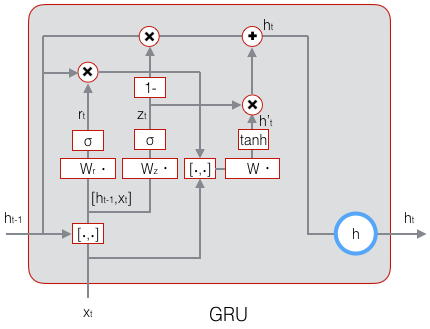
GRU的训练算法比LSTM简单一些,留给读者自行推导,本文就不再赘述了。
五、小结
至此,LSTM——也许是结构最复杂的一类神经网络——就讲完了,相信拿下前几篇文章的读者们搞定这篇文章也不在话下吧!现在我们已经了解循环神经网络和它最流行的变体——LSTM,它们都可以用来处理序列。但是,有时候仅仅拥有处理序列的能力还不够,还需要处理比序列更为复杂的结构(比如树结构),这时候就需要用到另外一类网络:递归神经网络(Recursive Neural Network),巧合的是,它的缩写也是RNN。





















 4209
4209











 被折叠的 条评论
为什么被折叠?
被折叠的 条评论
为什么被折叠?








